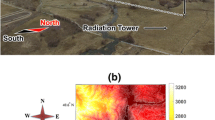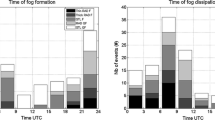Abstract
The Ebro river basin, in the northeastern part of the Iberian Peninsula in Europe, very often experiences radiation fog episodes in winter that can last for several days. The impact on human activities is high, especially on road and air transportation. The installation in July 2009 of a WindRASS in the area, which is able to work in the presence of fog, now allows inspecting the vertical structure of the temperature and wind profiles across the roughly 300-m-thick fog layer. We present a case study of a long-lasting (60 h) deep radiation fog that took place in December 2009 to obtain a deeper understanding of the dynamic processes governing such persistent fog. Field observations of vertical profiles of temperature, wind and turbulent kinetic energy are compared with a high-resolution mesoscale simulation, satellite imagery of fog distribution and observations taken in the area to understand why the fog is so persistent and how it dissipates only for a short period in the afternoon despite intermittent turbulence within the fog deck. The confinement of the fog inside a practically closed basin allows us to study the relevant physical processes in the establishment and subsequent evolution of the fog episode using a limited-area mesoscale model. The contribution of the WindRASS measurements allowed us to validate the numerical simulations, particularly inspecting the role of turbulence that can link the bottom and top of the fog through moderate episodic mixing. The fog layer has very weak winds inside, but is well mixed and experiences intermittent top-bottom turbulence generated in its upper part by convection due to radiative cooling and by wind shear due to the topographically generated flows that blow just above the top of the fog.






Similar content being viewed by others
References
Bergot T., Terradellas E., Cuxart J., Mira A., Liechti O., Mueller M., and Woetmann Nielsen N. (2007), Intercomparison of single-column numerical models for the prediction of radiation fog. J. Appl. Meteorol. Clim., 46, 504-521.
Caselles V., Valor E., Coll C., and Rubio, E. (1997), Thermal band selection for the PRISM instrument 1.Analysis of emissivity-temperature separation algorithms, J. Geophs. Res., 102, 11145-11164.
Cermak J., Eastman R. M., Bendix J., and Warren S. G. (2009), European climatology of fog and low stratus based on geostationary satellite observations, Q. J. R. Meteorol. Soc., 135, 2125-2130.
Coll C., Caselles V., Galve J.M., Valor E., Niclos R., Sanchez J.M., Rivas R. (2005), Ground measurements for the validation of land surface temperatures derive from AATSR and MODIS data, Remote Sens. Environ., 97, 288-300.
Cuxart J., Cunillera J., Jiménez M.A., Martínez D., Molinos F., Palau J.L. (2011), Study of mesobeta basin flows by remote sensing, Bound.-Layer Meteorol. (in press)
Cuxart J., Jiménez M.A. (2007), Mixing Processes in a Nocturnal Low-Level Jet: An LES Study, J. Atmos. Sci., 64, 1666-1679.
Cuxart J., Bougeault P., Redelsperger J.-L. (2000), A turbulence scheme allowing for mesoscale and large-eddy simulations, Q. J. Roy. Meteorol. Soc., 126, 1-30.
Duynkerke P.G. (1999), Turbulence, Radiation and fog in Dutch Stable Boundary Layers, Boundary-Layer Meteorology, 90, 447-477.
Fitzjarrald D.R., and Lala G.G. (1989), Hudson Valley Fog Environments, J. Appl. Meterol., 28, 1303-1328.
Gultepe I., Tardif R., Michaelides S. C., Cermak J., Bott A., Bendix J., Müller M. D., Pagowski M., Hansen B., Ellrod G., Jacobs W., Toth G., and Cober S. G. (2007), Fog Research: A Review of Past Achievements and Future Perspectives, Pure Appl. Geophys., 164, 1121-1159
Haeffelin M., Bergot T., Elias T., Tardif R., Carrer D., Chazette P., Colomb M., Drobinski P., Dupont E., Dupont J.-C., Gomes L., Musson-Genon L., Pietras C., Plana-Fattori A., Protat A., Rangognio J., Raut J.-C., Rémy S., Richard D., Sciare J., and Zhang X. (2010), PARISFOG: Shedding New Light on Fog Physical Processes, Bull. Amer. Meterol. Soc, 91, 767-783.
Jiménez M.A., Mira A., Cuxart J., Luque A., Alonso S., Guijarro J.A. (2008), Verification of a clear-sky mesoscale simulation using satellite-derived surface temperatures, Mon. Wea. Rev., 136, 5148-5161.
Jiménez M. A., and Cuxart J. (2005), Large-Eddy simulations of the stable boundary layer using the standard Kolmogorov theory: Range of applicability, Bound.-Layer. Meteor., 115, 241-261.
Lafore J.P., Stein J., Asencio N., Bougeault P., Ducrocq V., Duron J., Fisher C., Héreil P., Mascart P., Pinty J.-P., Redelsperger J.-L., Richard E., Vilá-Guerau de Arellano J. (1998), The Meso-NH atmospheric simulation system. Part I: Adiabatic formulation and control simulation, Ann. Geophys., 16 90-109.
Martínez D., Jiménez M.A., Cuxart J., Mahrt L. (2010), Heterogeneous Nocturnal Cooling in a Large Basin Under Very Stable Conditions, Bound.-Layer Meteorol., 137, 97-113.
Martínez D., Cuxart J., and Cunillera J. (2008), Conditioned climatology for stably stratified nights in the Lleida area. Journal of Weather and Climate of the Western Mediterranean, Tethys, 5, 13-24.
Mlawer, E.J., Taubman S.J., Brown P.D., Iacono M.J., and Clough S.A. (1997), Radiative transfer for inhomogeneous atmospheres: RRTM, a validated correlated-k model for the longwave, J. Geophys. Res., 102, 16663-16682.
Nakanishi M. (2000), Large-eddy simulation of radiation fog, Bound.-Layer Meteor., 94, 461-493.
Noilhan J., Planton S. (1989), A simple parameterization of land surface processes for meteorological models, Mon. Wea. Rev., 117, 536-549.
Pinty J.-P., and Jabouille P. (1998), A mixed-phase cloud parameterization for use in mesoscale non-hydrostatic model: simulations of a squall line and of orographic precipitations. Proc. Conf. of Cloud Physics, Everett, WA, USA, Amer. Meteor. Soc., August 1999, 217-220.
Salomonson V.V., Bames W.L., Maymon W.P., Montgomery H., and Ostrow H. (1989), MODIS: advanced facility instrument for studies of the Earth as a system. IEEE Trans. Geosci. Remote Sens., 27 145-153.
van der Velde I.R., Steeneveld, G.J., Wichers Schreur, B.G.J. and Holtslag, A.A.M. (2010), Modeling and forecasting the onset and duration of severe radiation fog under frost conditions, Mon. Wea. Rev., 138, 4237-4253.
Vicente-Serrano, S.M., Lopez-Moreno, J.I., Vega-Rodriguez, M.I., Begeria, S., Cuadrat, J.M. (2010), Comparison of regression techniques for mapping fog frequency: application to the Aragon region (northeast Spain), International Journal of Climatology, 30: 935-945.
Wan Z., and Dozier, J. (1996), A generalised split-window algorithm for retrieving land-surface temperature from space, IEEE Trans. Geosci. Remote Sens., 34, 892-905.
Wan Z., and Li Z.-L. (1997), A physics-based algorithm for retrieving land-surface emissivity and temperature from EOS/MODIS data, IEEE Trans. Geosci. Remote Sens., 35, 980-996.
Wobrock W., Schell D., Maser R., Kessel M., Jaeschke W., Fuzzi S., Facchini M.C., Orsi G., Marzorati A., Winkler P., G. Arends B.G., and Bendix J. (1992), Meteorological characteristics of the Po Valley fog, Tellus B, 55, 469-488.
Zhou B., and Ferrier B.S. (2008), Asymptotic Analysis of Equilibrium in Radiation Fog, J. Appl. Meteor. Climatol., 47, 1704-1722.
Acknowledgements
ECMWF and AEMET are thanked for the access to computing time. We also thank Jordi Cunillera and Antonio Gázquez (SMC) for access to data from the SMC Network and from the special devices installed in Raimat, Armand Alvarez (AEMET) for his support and knowledge of the local meteorology, Felipe Molinos for the initial treatment of the WindRASS and fog data, Daniel Martinez for insightful comments on the manuscript, and the Meso-NH team in Meteo France and Laboratoire d’Aérologie. This work was partially funded by SMC and through project CGL2009-12797-C03-01 of the Spanish Government also supplied with European FEDER funds. Data from MODIS are distributed by the Land Processes Distributed Active Archive Center (LPDAAC) located at the US Geological Survey (USGS) Earth Resources Observation and Science (EROS) Center (http://www.lpdaac.usgs.gov).
Author information
Authors and Affiliations
Corresponding author
Rights and permissions
About this article
Cite this article
Cuxart, J., Jiménez, M.A. Deep Radiation Fog in a Wide Closed Valley: Study by Numerical Modeling and Remote Sensing. Pure Appl. Geophys. 169, 911–926 (2012). https://doi.org/10.1007/s00024-011-0365-4
Received:
Revised:
Accepted:
Published:
Issue Date:
DOI: https://doi.org/10.1007/s00024-011-0365-4




